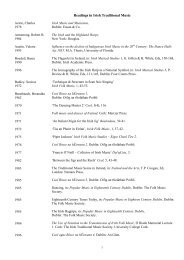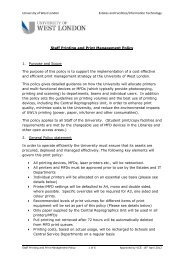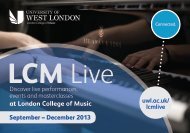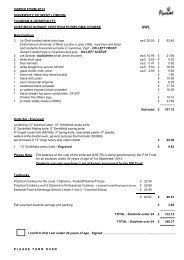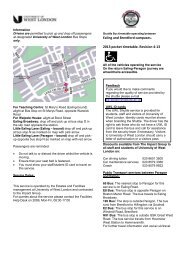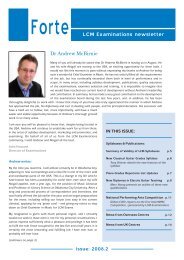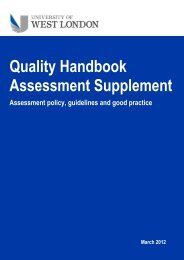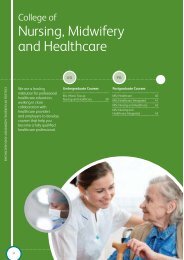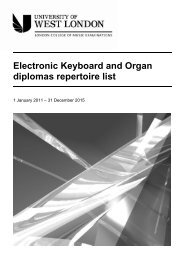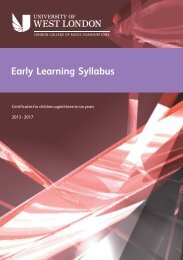Drum Kit repertoire list - University of West London
Drum Kit repertoire list - University of West London
Drum Kit repertoire list - University of West London
Create successful ePaper yourself
Turn your PDF publications into a flip-book with our unique Google optimized e-Paper software.
DRUM KITContentsPageThe Philosophy <strong>of</strong> this Syllabus .......................................... 3Publications ......................................................................... 3Guidelines ........................................................................... 4Related Examinations ......................................................... 5Examination Formats .......................................................... 5Grade 1 ............................................................................... 6Grade 2 ............................................................................... 7Grade 3 ............................................................................... 8Grade 4 ............................................................................... 9Grade 5 ............................................................................... 10Grade 6 ............................................................................... 11Grade 7 ............................................................................... 12Grade 8 ............................................................................... 13Viva Voce ............................................................................ 14Aural Tests .......................................................................... 16This <strong>repertoire</strong> <strong>list</strong> should be read in conjunction with the current MusicGrades Syllabus. Copies are available free <strong>of</strong> charge via our website,uwl.ac.uk/lcmexams, or from the LCM Examinations <strong>of</strong>fice.Please refer to the Music Grades Syllabus for full details about gradedexams, recital grades, leisure play exams and performance awards.This <strong>repertoire</strong> <strong>list</strong> is valid from 1 January 2009 until 31 December 2015.
LCM ExaminationsDirector <strong>of</strong> ExaminationsJohn Howard BA PhDChief Examiner in MusicPhilip Aldred BEd FLCMLCM Examinations<strong>University</strong> <strong>of</strong> <strong>West</strong> <strong>London</strong>St Mary’s RoadEaling<strong>London</strong>W5 5RFtel: +44 (0)20 8231 2364email: lcm.exams@uwl.ac.ukuwl.ac.uk/lcmexams© Copyright 2011 by the <strong>University</strong> <strong>of</strong> <strong>West</strong> <strong>London</strong>, LCM ExaminationsMay 2013 edition2
GuidelinesEQUIPMENT:1. Candidates will be expected to provide their own drum kit, unless arrangements are made inadvance with the centre representative to use equipment at the venue. It is the responsibility <strong>of</strong> thecandidate to ensure that instruments required for all items are available.2. Time will be allowed at the beginning <strong>of</strong> the examination to adjust the kit, but this should not exceed 3minutes. The kit itself should be set up well in advance <strong>of</strong> the examination start time, and dismantledlater.3. A five-piece drum kit is required for all grades. A single crash/ride cymbal (in addition to hi-hats) may beused for Grades 1 and 2. A separate crash cymbal is required for Grade 3 and above. Electronic kits arenot permitted. ‘Flats’ may only be used up to and including Grade 4.4. A candidate using inappropriate or damaged sticks may be prevented from taking the examination.5. Candidates should bring their own sticks and music to the examination.6. If, in the opinion <strong>of</strong> the examiner, a candidate’s choice <strong>of</strong> sticks or technique demonstrates a potential todamage instruments, and/or if the dynamic level <strong>of</strong> the performance combined with the acoustics <strong>of</strong> theexamination venue constitutes a health and safety hazard, the examinations can be terminated.7. Centre representatives should note that a CD player is required for the administration <strong>of</strong> the aural testsat Grades 6-8. In some circumstances a CD player will also be required for lower grades.TECHNICAL GUIDELINES:1. Rudiments may be played using left-hand leads, if appropriate, by left-handed players. If a left-handed kitarrangement is required then a separate kit will be required in the examination room.2. Suggested tempi for all requirements are <strong>list</strong>ed in the examination books.3. All Technical Work requirements (Rudiments) must be played as written (including repeats) frommemory.4. Crushed rolls may be used in all pieces. A high standard <strong>of</strong> rolling is not expected in Grades 1-3.5. Some limited creative embellishment <strong>of</strong> the printed score is acceptable when performing theaccompanied piece at Grade 6 and above.6. Candidates should consult and use the examination handbook for the relevant grade which contains allthe required music and also gives fuller details, examples and information on ALL sections <strong>of</strong> theexamination. Photocopies are not permitted (see syllabus Regulation 22).7. At Grades 7 & 8, candidates should use their discretion in adapting the tempi <strong>of</strong> linked rudiments to enablethe links to be fluent and musical.ACCOMPANIMENT:1. All candidates at Grades 1-6 must select TWO solo pieces and ONE accompanied piece for their exam(pre-recorded backing track or live piano accompaniment). At Grades 7-8 candidates must choose ONEsolo piece, ONE Time Sequence Study to be performed with a click track, and ONE accompanied piece.2. All pieces must be performed as published in the Handbooks, i.e. accompanied pieces may not beperformed solo, and solo pieces may not be performed with accompaniment.3. At Grades 1-4, piano accompaniments are published for three pieces per grade. At Grades 5-8 only onepiano accompaniment is published. If a piano accompaniment is used, this must be performed live. Apre-recorded piano accompaniment will not be acceptable. (The piece ‘<strong>Drum</strong> and Bass Groove’ at Grade8 is published with bass guitar accompaniment and the same conditions apply.)4. CDs containing pre-recorded backing tracks for accompanied pieces are included with the handbooks.Candidates using these CDs in the examination are responsible for providing their own playbackequipment (see syllabus Regulation 23). CDs used must be published by LCM Examinations – the use<strong>of</strong> copies is not permitted.5. Candidates entering for Leisure Play examinations may present a solo programme.4
Related ExaminationsLCM Examinations <strong>of</strong>fers examinations in a wide range <strong>of</strong> subjects, covering classical, jazz, pop/rock andtraditional music genres. The following syllabuses may also be <strong>of</strong> interest:• Graded, recital grade and leisure play examinations and performance awards in tuned percussion,snare drum, timpani and combined percussion• Performance diplomas (four levels) in percussion• Teaching diplomas (three levels) in percussionA flexible Ensemble syllabus is also available, catering for all types <strong>of</strong> ensemble from duets and trios up toconcert bands and wind bands. Six levels are <strong>of</strong>fered, ranging from Grades 1-2 to DipLCM standard.Syllabuses are available free <strong>of</strong> charge via our website uwl.ac.uk/lcmexams or on request from the LCMExams <strong>of</strong>fice.Examination FormatsFollowing is an overview <strong>of</strong> the four examination formats <strong>of</strong>fered by LCM Examinations: grades, recitalgrades, leisure play and performance awards. Refer to the relevant section <strong>of</strong> the Music Grades Syllabus forfull details.Grades Recital Grades Leisure PlayPerformanceAwardsTechnical Work Performance3 pieces4 (or 5) pieces,all selected from<strong>repertoire</strong> <strong>list</strong>4 pieces (3 selectedfrom grade <strong>list</strong>, plus1 own choice)3 piecesViva VoceSight ReadingOptional forComponent 2 Optional forComponent 2 Aural Tests Structure Grades 1-8 Grades 1-8 Levels 1-8 Levels 1-8Pre-requisites Assessment Examination Examination Examination DVDGradingPass: 65-74%Merit: 75-84%Distinction: 85-100%Pass: 65-74%Merit: 75-84%Distinction: 85-100%Pass: 65-74%Merit: 75-84%Distinction: 85-100%Pass: 65-74%Merit: 75-84%Distinction: 85-100%OfqualAccreditation 5
DRUM KIT: GRADE ONEComponent 1 - Technical Work (Rudiments)15 marksTo be played from memory, as shown in the Handbook:1. Single Stroke Roll2. Double Stroke Roll3. ParadiddlesThe examiner will ask for a selection <strong>of</strong> these to be performed.Component 2 - Performance60 marksPerformance <strong>of</strong> three pieces, one from each <strong>list</strong>: A, B and C.TWO solo pieces and ONE accompanied piece (*) must be chosen.A Jack Richards BreakerAidan Geary Tiptoe Rock* Tony Stockley PsychedelicB Claire Brock Rock WaltzAidan Geary The Typewriter* Tony Stockley Lazy SummerC Brian Stone The Caterpillar RhumbaClaire BrockTwo Tribes* Jack Richards Pipe DreamComponent 3 - Viva Voce7 marksSee pages 14-15.Component 4 - Sight Reading10 marksUp to one minute’s preparation time will be allowed to study the test before playing, during which thecandidate may try parts <strong>of</strong> the test if they wish. Tests may include repeat bars.Component 5 - Aural Tests8 marksSee pages 16-18.The LCM Grade 1 & 2 <strong>Drum</strong> <strong>Kit</strong> Handbook (LL207) contains all the pieces set for this examination,and includes a CD containing backing tracks for accompanied pieces (these three pieces are alsopublished with piano accompaniment). The book also contains all the required Rudiments, togetherwith examples <strong>of</strong> the Viva Voce, Sight Reading, and Aural Tests sections <strong>of</strong> the examination. Seepage 5 for details.6
DRUM KIT: GRADE TWOComponent 1 - Technical Work (Rudiments)15 marksTo be played from memory, as shown in the Handbook:1. Single Stroke Roll2. Double Stroke Roll3. Paradiddles4. Flams5. Drags6. Ruffs7. Five Stroke Roll8. Seven Stroke Roll9. Nine Stroke RollThe examiner will ask for a selection <strong>of</strong> these to be performed.Component 2 - Performance60 marksPerformance <strong>of</strong> three pieces, one from each <strong>list</strong>: A, B and C.TWO solo pieces and ONE accompanied piece (*) must be chosen.A Aidan Geary Jarg RockAidan Geary Pick up the Beat* Allan Gubbins Rock UpB Brian Stone Drill It!Aidan Geary Trooping the Colour* Aidan Geary The Temple SkipC Jack Richards Simple SambaBrian StoneRambo Mambo* Tony Stockley RattlesnakeComponent 3 - Viva Voce7 marksSee pages 14-15.Component 4 - Sight Reading10 marksUp to one minute’s preparation time will be allowed to study the test before playing, during which thecandidate may try parts <strong>of</strong> the test if they wish. Tests may include repeat bars.Component 5 - Aural Tests8 marksSee pages 16-18.The LCM Grade 1 & 2 <strong>Drum</strong> <strong>Kit</strong> Handbook (LL207) contains all the pieces set for this examination,and includes a CD containing backing tracks for accompanied pieces (these three pieces are alsopublished with piano accompaniment). The book also contains all the required Rudiments, togetherwith examples <strong>of</strong> the Viva Voce, Sight Reading, and Aural Tests sections <strong>of</strong> the examination. Seepage 5 for details.7
DRUM KIT: GRADE THREEComponent 1 - Technical Work (Rudiments)15 marksTo be played from memory, as shown in the Handbook:1. Single Strokes2. Double Strokes3. Paradiddles4. Flams5. Drags6. Ruffs7. Five Stroke Roll8. Seven Stroke Roll9. Nine Stroke Roll10. Flam Tap11. Double Paradiddle12. Paradiddle DiddleThe examiner will ask for a selection <strong>of</strong> these to be performed.Component 2 - Performance60 marksPerformance <strong>of</strong> three pieces, one from each <strong>list</strong>: A, B and C.TWO solo pieces and ONE accompanied piece (*) must be chosen.A Brian Stone Get ItAidan Geary Ronnie’s Rush* Tony Stockley Jump BackB Daniel Earley Even SwirlAidan Geary Wiley Jazz Waltz* Jack Richards Gospel OakC John Mitchell Samba ReggaeDaniel Earley Rhumba-bumba* Tony Stockley Cool BreezeComponent 3 - Viva Voce7 marksSee pages 14-15.Component 4 - Sight Reading10 marksThe extract may include simple fills, repeat bars and ad lib. sections. Up to one minute’s preparation timewill be allowed to study the test before playing, during which the candidate may try parts <strong>of</strong> the test if theywish.Component 5 - Aural Tests8 marksSee pages 16-18.The LCM Grade 3 & 4 <strong>Drum</strong> <strong>Kit</strong> Handbook (LL208) contains all the pieces set for this examination,and includes a CD containing backing tracks for accompanied pieces (these three pieces are alsopublished with piano accompaniment). The book also contains all the required Rudiments, togetherwith examples <strong>of</strong> the Viva Voce, Sight Reading, and Aural Tests sections <strong>of</strong> the examination. Seepage 5 for details.8
DRUM KIT: GRADE FOURComponent 1 - Technical Work (Rudiments)15 marksTo be played from memory, as shown in the Handbook:1. Single Strokes2. Double Strokes3. Paradiddles4. Flams5. Drags6. Ruffs7. Five Stroke Roll8. Seven Stroke Roll9. Nine Stroke Roll10. Flam Accent11. Flamacue12. Flam Tap13. Drag and Stroke14. Double Drag and Stroke15. Double Paradiddle16. Paradiddle DiddleThe examiner will ask for a selection <strong>of</strong> these to be performed.Component 2 - Performance60 marksPerformance <strong>of</strong> three pieces, one from each <strong>list</strong>: A, B and C.TWO solo pieces and ONE accompanied piece (*) must be chosen.A Jimmy Roman Break That BeatAidan Geary X-hat Men* Allan Gubbins Ghost TownB Daniel Earley Show Off!Clive Malabar Shuffle Up* Allan Gubbins ShuffledomC Phil Bailey Splash OutPeter Precious Caribbean Carnival* Claire Brock Country GirlComponent 3 - Viva Voce7 marksSee pages 14-15.Component 4 - Sight Reading10 marksThe extract may include simple fills, repeat bars and ad lib. sections. Up to one minute’s preparation timewill be allowed to study the test before playing, during which the candidate may try parts <strong>of</strong> the test if theywish.Component 5 - Aural Tests8 marksSee pages 16-18.The LCM Grade 3 & 4 <strong>Drum</strong> <strong>Kit</strong> Handbook (LL208) contains all the pieces set for this examination,and includes a CD containing backing tracks for accompanied pieces (these three pieces are alsopublished with piano accompaniment). The book also contains all the required Rudiments, togetherwith examples <strong>of</strong> the Viva Voce, Sight Reading, and Aural Tests sections <strong>of</strong> the examination. Seepage 5 for details.9
DRUM KIT: GRADE FIVEComponent 1 - Technical Work (Rudiments)15 marksTo be played from memory, as shown in the Handbook:1. Single Strokes2. Double Strokes3. Paradiddles4. Flams5. Drags6. Ruffs7. Five Stroke Roll8. Seven Stroke Roll9. Nine Stroke Roll10. Flam Accent11. Flamacue12. Flam Tap13. Flam Paradiddles14. Drag Paradiddles15. Drag and Stroke16. Double Drag and Stroke17. Double Paradiddles18. Paradiddle DiddleThe examiner will ask for a selection <strong>of</strong> these to be performed.Component 2 - Performance60 marksPerformance <strong>of</strong> three pieces, one from each <strong>list</strong>: A, B and C.TWO solo pieces and ONE accompanied piece (*) must be chosen.A Tony Stockley Off the HatDaniel Earley Disco Waves* Jack Richards Hobo’s GrooveB Brian Stone March AroundMatthew Thomas Anyone for Tens?* Allan Gubbins One Man SambaC Tony Stockley Swing ItAidan Geary East Side Swing* Aidan Geary Ice Cream Scooper ♫Component 3 - Viva Voce7 marksSee pages 14-15.Component 4 - Sight Reading10 marksThe extract may include fills, repeat bars, and limited improvisation. Up to one minute’s preparation time willbe allowed to study the test before playing, during which the candidate may try parts <strong>of</strong> the test if they wish.Component 5 - Aural Tests8 marksSee pages 16-18.The LCM Grade 5 & 6 <strong>Drum</strong> <strong>Kit</strong> Handbook (LL209) contains all the pieces set for this examination,and includes a CD containing backing tracks for accompanied pieces (one piece (♫) is alsopublished with piano accompaniment). The book also contains all the required Rudiments, togetherwith examples <strong>of</strong> the Viva Voce, Sight Reading, and Aural Tests sections <strong>of</strong> the examination. Seepage 5 for details.10
DRUM KIT: GRADE SIXComponent 1 - Technical Work (Rudiments)15 marksTo be played from memory, as shown in the Handbook:1. Single Strokes2. Double Strokes3. Paradiddles4. Flams5. Drags6. Ruffs7. Five Stroke Roll8. Seven Stroke Roll9. Nine Stroke Roll10. Eleven Stroke Roll11. Flam Accent12. Flamacue13. Flam Tap14. Flam Paradiddles15. Drag Paradiddles16. Drag and Stroke17. Double Drag and Stroke18. Double Paradiddles19. Paradiddle Diddle20. Swiss Army TripletsThe examiner will ask for a selection <strong>of</strong> these to be performed.Component 2 - Performance60 marksPerformance <strong>of</strong> three pieces, one from each <strong>list</strong>: A, B and C.TWO solo pieces and ONE accompanied piece (*) must be chosen.A Jack Richards Stand ByTony Stockley Latrok* Allan Gubbins Isla DanceB Brian Stone One and SixMiles Williams Rollercoaster* Claire Brock Deuce’s Shuffle ♫C Tony Stockley RockingBrian StoneOut and Round* Aidan Geary Cazza’s ImprovComponent 3 - Viva Voce7 marksSee pages 14-15.Component 4 - Sight Reading10 marksThe extract may include fills, repeat bars, and limited improvisation. Up to one minute’s preparation time will be allowedto study the test before playing, during which the candidate may try parts <strong>of</strong> the test if they wish.Component 5 - Aural Tests8 marksSee pages 16-18.The LCM Grade 5 & 6 <strong>Drum</strong> <strong>Kit</strong> Handbook (LL209) contains all the pieces set for this examination,and includes a CD containing backing tracks for accompanied pieces, and aural test specimenextracts. One piece (♫) is published with piano accompaniment. The book also contains all therequired Rudiments, together with examples <strong>of</strong> the Viva Voce, Sight Reading, and Aural Testssections <strong>of</strong> the examination. See page 5 for details.11
DRUM KIT: GRADE SEVENComponent 1 - Technical Work (Rudiments)To be played from memory, as shown in the Handbook.1. Single Strokes2. Double Strokes3. Paradiddles4. Flams5. Drags6. Ruffs7. Five Stroke Roll8. Seven Stroke Roll9. Nine Stroke Roll10. Eleven Stroke Roll11. Flam Accent12. Flamacue13. Flam Tap14. Flam Paradiddles15. Drag Paradiddles16. Drag and Stroke17. Double Drag and Stroke18. Double Paradiddles19. Paradiddle Diddle20. Swiss Army Triplets15 marksThe examiner will ask for a selection <strong>of</strong> these to be performed. In addition, the examiner may request anyTWO <strong>of</strong> the above rudiments to be combined into a single pattern, in the order: ABAB-fill. Candidatesshould use their discretion in adapting the tempi <strong>of</strong> linked rudiments to enable the links to be fluent andmusical.Component 2 - PerformancePerformance <strong>of</strong> three pieces. ONE solo piece, ONE piece performed with a click track ( † ) and ONEaccompanied piece (*) must be chosen.Aidan Geary Funk the Stuff†Brian Stone Time Sequence Study 1* Aidan Geary Power TowerBrian StoneThe Style Machine†Jack Richards Time Sequence Study 2* Miles Williams Latin for my Valentine ♫Brian StoneUrban Mix†Jack Richards Time Sequence Study 3* Allan Gubbins Hippedy HopNB: references to Lists A, B and C in the Grade 7 & 8 Handbook should be disregarded.60 marksComponent 3 - Viva VoceSee pages 14-15.7 marksComponent 4 - Sight ReadingThe extract may include fills, repeat bars and improvisation. Up to one minute’s preparation time will beallowed to study the test before playing, during which the candidate may try parts <strong>of</strong> the test if they wish.10 marksComponent 5 - Aural TestsSee pages 16-18.8 marksThe LCM Grade 7 & 8 <strong>Drum</strong> <strong>Kit</strong> Handbook (LL210) contains all the pieces set for this examination,and includes a CD containing backing tracks for accompanied pieces and aural test specimenextracts. One piece (♫) is published with piano accompaniment. The book also contains all therequired Rudiments, together with examples <strong>of</strong> the Viva Voce, Sight Reading, and Aural Testssections <strong>of</strong> the examination. See page 5 for details.12
DRUM KIT: GRADE EIGHTComponent 1 - Technical Work (Rudiments)To be played from memory, as shown in the Handbook:1. Single Strokes2. Double Strokes3. Paradiddles4. Flams5. Drags6. Ruffs7. Five Stroke Roll8. Seven Stroke Roll9. Nine Stroke Roll10. Eleven Stroke Roll11. Flam Accent12. Flamacue13. Flam Tap14. Flam Paradiddles15. Drag Paradiddles16. Drag and Stroke17. Double Drag and Stroke18. Double Paradiddles19. Paradiddle Diddle20. Swiss Army Triplets15 marksThe examiner will ask for a selection <strong>of</strong> these to be performed. In addition, the examiner may request anyTHREE <strong>of</strong> the above rudiments to be combined into a single pattern, in the order: ABC-ABC-fill. Candidatesshould use their discretion in adapting the tempi <strong>of</strong> linked rudiments to enable the links to be fluent andmusical.Component 2 - PerformancePerformance <strong>of</strong> three pieces. ONE solo piece, ONE piece performed with a click track ( † ) and ONEaccompanied piece (*) must be chosen.60 marksTony Stockley Jack’s X/Hat Groove†Aidan Geary Time Sequence Study 1* Claire Brock Five Days [NB: to be performed with CD]Claire BrockTumbao†Aidan Geary Time Sequence Study 2* Tony Stockley <strong>Drum</strong> and Bass Groove [NB. to be performed with live bass guitar accompaniment]Peter Precious Show <strong>of</strong> Hands†Aidan Geary Time Sequence Study 3* John Mitchell Curtain Up [NB. to be performed with live piano accompaniment]NB: references to Lists A, B and C in the Grade 7 & 8 Handbook should be disregarded.Component 3 - Viva VoceSee pages 14-15.7 marksComponent 4 - Sight ReadingThe extract may include fills, repeat bars and improvisation. Up to one minute’s preparation time will beallowed to study the test before playing, during which the candidate may try parts <strong>of</strong> the test if they wish.10 marksComponent 5 - Aural TestsSee pages 16-18.8 marksThe LCM Grade 7 & 8 <strong>Drum</strong> <strong>Kit</strong> Handbook (LL210) contains all the pieces set for this examination,and includes a CD containing backing tracks for accompanied pieces and aural test specimenextracts. Accompaniment parts for Bass guitar / Piano are provided for starred pieces. The bookalso contains all the required Rudiments, together with examples <strong>of</strong> the Viva Voce, Sight Reading,and Aural Tests sections <strong>of</strong> the examination. See page 5 for details.13
Viva VoceNotes:1. Most questions and answers are verbal; however, some responses may require candidates toindicate certain parts <strong>of</strong> the drum kit, and from Grade 4 onwards there is a requirement todemonstrate certain rhythmic styles by playing them on the kit. Otherwise, candidates are notexpected to demonstrate on the drum kit; but they may choose to do so if they feel that this wouldclarify their answer.2. There is no set form <strong>of</strong> words, or number <strong>of</strong> questions. Examiners are encouraged to conduct thetests in a flexible and conversational manner. The number <strong>of</strong> questions asked, and the content <strong>of</strong>the questions, may differ from candidate to candidate. However, the prime focus for the Viva Vocewill always be the music performed in the Performance section <strong>of</strong> the exam, together with technicalknowledge <strong>of</strong> the drum kit.3. The knowledge required for the Viva Voce is cumulative for Grades 1-8; i.e. any knowledge requiredin earlier grades is required for later grades.4. Although accuracy and appropriateness <strong>of</strong> response are the principal criteria <strong>of</strong> assessment,examiners will also look for articulacy, use <strong>of</strong> correct terminology, and a sense <strong>of</strong> engagement with,and understanding <strong>of</strong>, the music performed.5. Sample questions are given in the Handbooks.Requirements:GRADE 1Candidates should be able to:• name, and explain the meaning <strong>of</strong>, all basic notational elements in the music performed in the Performancecomponent <strong>of</strong> the exam (drum kit parts only), including: staff, bars and bar-lines, stave position <strong>of</strong> different kitcomponents, rhythmic values <strong>of</strong> notes and rests (including dotted notes), time signatures, dynamics,articulation markings, ornaments, rolls, and any additional markings;• explain which is their favourite piece and why;• assign simple descriptive words to pieces to describe their mood ('happy', 'sad', 'bouncy', 'jazzy', 'gentle',etc.)• identify all the names <strong>of</strong> the drums in the kit (illustrated in the examination handbook);• explain the origin <strong>of</strong> the name <strong>of</strong> the snare drum and the name <strong>of</strong> its components (illustrated in theexamination handbook).GRADE 2In addition to the requirements for Grade 1, candidates may be asked to:• explain the function and use <strong>of</strong> the various components <strong>of</strong> the drum kit.GRADE 3In addition to the requirements for Grades 1 and 2, candidates may be asked to:• describe the mood or character <strong>of</strong> pieces using appropriate descriptive terminology ('fast and lively', 'gentleand flowing', 'like a dance', etc.);• identify contrasts <strong>of</strong> mood within pieces;• discuss any pictorial or descriptive element <strong>of</strong> the music.14
GRADE 4In addition to the requirements for Grades 1-3, candidates may be asked to:• discuss their approaches to learning the pieces, and to identify any particular difficulties (musical ortechnical) which were encountered;• answer questions on tuning techniques and durability <strong>of</strong> heads <strong>of</strong> the drum kit;• demonstrate some knowledge <strong>of</strong> the following rhythmic styles: March, Latin, Shuffle, Rock and Swing.GRADE 5In addition to the requirements for Grades 1-4, candidates may be asked to:• demonstrate knowledge <strong>of</strong> basic formal structures (e.g. contrasting or repeated sections);• describe the style <strong>of</strong> the music performed, and show a developing understanding <strong>of</strong> rhythmic styles,including disco.GRADE 6In addition to the requirements for Grades 1-5, candidates may be asked to:• discuss their personal responses to the music performed: the extent to which they like or dislike it, or find itchallenging or rewarding, and why;• approaches to learning the music, including the use <strong>of</strong> certain techniques, and aspects <strong>of</strong> interpretation;• demonstrate knowledge <strong>of</strong> formal structures (e.g. ternary, binary, rondo etc.), and <strong>of</strong> formal patterning withinthe music (e.g. repetition or variation <strong>of</strong> certain rhythmic figures);• demonstrate a self-critical awareness <strong>of</strong> their own performance, indicating to the examiner which aspects <strong>of</strong>their performance they were happy or unhappy with, and why;• show a competent awareness <strong>of</strong> the rhythmic style and use <strong>of</strong> the drum kit such as may be found in showmusic and concert bands;• demonstrate knowledge and understanding <strong>of</strong> the construction and use <strong>of</strong> various specia<strong>list</strong> drum kits.GRADE 7In addition to the requirements for Grades 1-6, candidates may be asked to:• demonstrate a widening musical awareness a little beyond the music performed;• identify the style <strong>of</strong> a fundamental rhythm pointed out in the book by the examiner;• demonstrate a thorough knowledge <strong>of</strong> the workings and maintenance <strong>of</strong> the drum kit and the effect <strong>of</strong>different pieces <strong>of</strong> equipment available, e.g. fusion kit, effects cymbals, etc.GRADE 8In addition to the requirements for Grades 1-7, candidates may be asked to:• discuss with the examiner a range <strong>of</strong> issues arising from the music performed, demonstrating evidence <strong>of</strong> arounded musical awareness, in terms both <strong>of</strong> the <strong>repertoire</strong> itself, and the candidate's response to it as aperformer;• discuss with the examiner those styles and performers which have been influential in the development <strong>of</strong>their own playing;• demonstrate a comprehensive knowledge <strong>of</strong> recognised musical styles and some <strong>of</strong> the history anddevelopment <strong>of</strong> the drum kit.15
Aural TestsNotes:1. These tests are normally administered by the examiner using the drum kit. Where this is the case,the candidate is permitted to watch while the examiner plays the extracts. However, in certaincircumstances, tests using drum kit extracts may be administered using a CD. For furtherinformation, please contact LCM Examinations.2. Specimen test examples are given in the Handbooks. Candidates and teachers should note that,even though the format <strong>of</strong> some tests stays the same from grade to grade, the complexity <strong>of</strong> theexamples used increases.3. Candidates may request any test to be given one repeat playing without loss <strong>of</strong> marks.4. Please note that the printed wording is a guide only. Examiners are encouraged to conduct the testsin a conversational manner.Requirements:GRADE 1A click-pulse will be given, followed by a rhythmic phrase played twice on the snare drum, in one <strong>of</strong> thefollowing time signatures: 2/4, 3/4, 4/4. Candidates will be asked to:1. state the time signature [2 marks].The candidate will be given a copy <strong>of</strong> three notated extracts. One <strong>of</strong> these extracts will be played, twice, onthe drum kit. Candidates will be asked to:2. state which extract was played [2 marks].A short rhythmic phrase will be played, twice, on the drum kit. Candidates will be asked to:3. play the phrase back [2 marks].A short phrase will be played, twice, on the drum kit. Candidates will be asked to:4. state the style <strong>of</strong> the extract played. The extract will be in one <strong>of</strong> the following styles: 4/4 Rock, 3/4 Rock,Simple Latin (Examples are given in the Handbook) [2 marks].GRADE 2A click-pulse will be given, followed by a rhythmic phrase played twice on the snare drum, in one <strong>of</strong> thefollowing time signatures: 2/4, 3/4, 4/4, 6/8. Candidates will be asked to:1. state the time signature [2 marks].The candidate will be given a copy <strong>of</strong> three notated extracts. One <strong>of</strong> these extracts will be played, twice, onthe drum kit. Candidates will be asked to:2. state which extract was played [2 marks].A short rhythmic phrase will be played, twice, on the drum kit. Candidates will be asked to:3. play the phrase back [2 marks].A short phrase will be played, twice, on the drum kit. Candidates will be asked to:4. state the style <strong>of</strong> the extract played. The extract will be in one <strong>of</strong> the following styles: 4/4 Rock, 3/4 Rock,Simple Latin, 6/8 March, 2/4 March (Examples are given in the Handbook) [2 marks].16
GRADE 3A click-pulse will be given, followed by a rhythmic phrase played twice on the snare drum, in one <strong>of</strong> thefollowing time signatures: All those set for previous grades, plus 12/8. Candidates will be asked to:1. state the time signature [2 marks].The candidate will be given a copy <strong>of</strong> three notated extracts. One <strong>of</strong> these extracts will be played, twice, onthe drum kit. Candidates will be asked to:2. state which extract was played [2 marks].A short rhythmic phrase will be played, twice, on the drum kit. Candidates will be asked to:3. play the phrase back [2 marks].A short phrase will be played, twice, on the drum kit. Candidates will be asked to:4. state the style <strong>of</strong> the extract played. The extract will be in one <strong>of</strong> the following styles: All those set for previousgrades, plus Slow Blues, Bossa Nova (Examples are given in the Handbook) [2 marks].GRADE 4A click-pulse will be given, followed by a rhythmic phrase played twice on the drum kit, in one <strong>of</strong> the followingtime signatures: All those set for previous grades, plus 9/8. Candidates will be asked to:1. state the time signature [2 marks].The candidate will be given a copy <strong>of</strong> three notated extracts. One <strong>of</strong> these extracts will be played, twice, onthe drum kit. Candidates will be asked to:2. state which extract was played [2 marks].A short rhythmic phrase will be played, twice, on the drum kit. Immediately after the second playing,candidates will be asked to:3. play a suitable answering phrase [2 marks].A short phrase will be played, twice, on the drum kit. Candidates will be asked to:4. state the style <strong>of</strong> the extract played. The extract will be in one <strong>of</strong> the following styles: All those set for previousgrades, plus Shuffle, Swing (Examples are given in the Handbook) [2 marks].GRADE 5A click-pulse will be given, followed by a rhythmic phrase played twice on the drum kit, in one <strong>of</strong> the followingtime signatures: All those set for previous grades, plus 5/4. Candidates will be asked to:1. state the time signature [2 marks].The candidate will be given a copy <strong>of</strong> three notated extracts. One <strong>of</strong> these extracts will be played, twice, onthe drum kit. Candidates will be asked to:2. state which extract was played [2 marks].A short rhythmic phrase will be played, twice, on the drum kit. Immediately after the second playing,candidates will be asked to:3. play a suitable answering phrase [2 marks].A short phrase will be played, twice, on the drum kit. Candidates will be asked to:4. state the style <strong>of</strong> the extract played. The extract will be in one <strong>of</strong> the following styles: All those set for previousgrades, plus Disco 16, Reggae (Examples are given in the Handbook) [2 marks].17
GRADE 6An extract <strong>of</strong> music will be played, twice, via CD. This extract will take the form <strong>of</strong> a short instrumental ‘track’featuring a number <strong>of</strong> parts, but without drums. A chord chart will be given to the candidate; this will take theform <strong>of</strong> chord symbols and bars only and will not include any other information about the music heard.1. Candidates will be asked a selection <strong>of</strong> the following:• to state the time signature [from any set for previous grades, plus 2/2, 3/2, 4/2, 6/4, 9/4, 12/4];• to suggest an appropriate tempo marking;• to identify the style;• to state whether the music is in a major or minor key;• to describe and identify any particularly noticeable aspects <strong>of</strong> the instrumentation, dynamics, texture,tempo, melody, rhythmic figures, etc. [3 marks]A few bars, taken from the track, will be played in isolation, followed by another version <strong>of</strong> the same few bars,but this time incorporating some changes in aspects such as the tempo, dynamics, instrumentation, style, etc.Candidates will be asked to:2. identify the changes [2 marks].The full extract will be played again, twice. On the second playing, the candidate will be asked to:3. play along to the extract in a suitable style, taking account <strong>of</strong> any fluctuations <strong>of</strong> tempo, dynamics, texture,etc., and adding fills, etc. where appropriate. [3 marks]GRADE 7An extract <strong>of</strong> music will be played, twice, via CD. This extract will take the form <strong>of</strong> a short instrumental ‘track’featuring a number <strong>of</strong> parts, but without drums. A chord chart will be given to the candidate; this will take theform <strong>of</strong> chord symbols and bars only and will not include any other information about the music heard.1. Candidates will be asked a selection <strong>of</strong> the following:• to state the time signature [from any set for previous grades, plus 5/8, 7/8, 7/4];• to suggest an appropriate tempo marking;• to identify the style;• to state whether the music is in a major or minor key;• to describe and identify any particularly noticeable aspects <strong>of</strong> the instrumentation, dynamics, texture,tempo, melody, rhythmic figures, etc. [3 marks]A few bars, taken from the track, will be played in isolation, followed by another version <strong>of</strong> the same few bars,but this time incorporating some changes in aspects such as the tempo, dynamics, instrumentation, style, etc.Candidates will be asked to:2. identify the changes [2 marks].The full extract will be played again, twice. On the second playing, the candidate will be asked to:3. play along to the extract in a suitable style, taking account <strong>of</strong> any fluctuations <strong>of</strong> tempo, dynamics, texture,etc., and adding fills, etc. where appropriate. [3 marks]GRADE 8An extract <strong>of</strong> music will be played, twice, via CD. This extract will take the form <strong>of</strong> a short instrumental ‘track’featuring a number <strong>of</strong> parts, but without drums. A chord chart will be given to the candidate; this will take theform <strong>of</strong> chord symbols and bars only and will not include any other information about the music heard.1. Candidates will be asked a selection <strong>of</strong> the following:• to state the time signature;• to suggest an appropriate tempo marking;• to identify the style;• to state whether the music is in a major or minor key;• to describe and identify any particularly noticeable aspects <strong>of</strong> the instrumentation, dynamics, texture,tempo, melody, rhythmic figures, etc. [3 marks]A few bars, taken from the track, will be played in isolation, followed by another version <strong>of</strong> the same few bars,but this time incorporating some changes in aspects such as the tempo, dynamics, instrumentation, style, etc.Candidates will be asked to:2. identify the changes [2 marks].The full extract will be played again, twice. On the second playing, the candidate will be asked to:3. play along to the extract in a suitable style, taking account <strong>of</strong> any fluctuations <strong>of</strong> tempo, dynamics, texture,etc., and adding fills, etc. where appropriate. [3 marks]18




